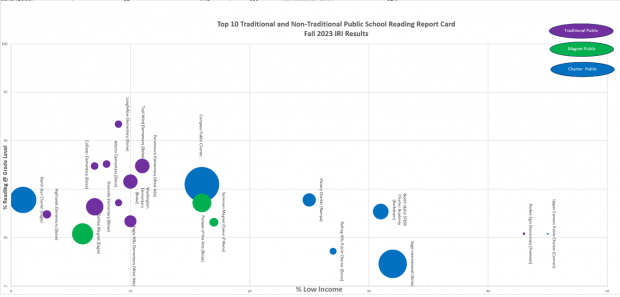The team at Idaho Ed News has done an admirable job in keeping our stakeholders informed on school and student performance. In the recent article, “Most at-risk kids are not reading at grade level” we learn that only about 58% of the 90,000 Idaho students in grades K-3 are reading at grade level.
This story follows closely after the “Fall IRI Top 10 Lists: Treasure Valley schools reign” article sharing the top 10 performing schools in both the traditional public and non-traditional public-school models. Earlier this month, Idaho Ed News reported that fall reading scores are showing improvement, but over 38,000 K-3 students are still reading below grade level.
It is no secret that early literacy is of paramount importance and Idaho’s policymakers and educators are right to focus on it. While Idaho is neither at the top nor the bottom of the list for highest performing states, as of 2022, Idaho ranks the same as the national (public) average percentage of fourth graders that are at or above NAEP Proficiency. We are average in a country that is mediocre in reading results.
Regardless of how we feel about our current reading results, the message is clear, we have more work to do. As a seasoned education leader, I call that an opportunity. The reality is, we will never be “done” with the work. With that caveat, there are also some shining examples of schools that are doing this work well in Idaho.
At my organization Bluum, our approach to looking at things differently is a common practice. Take the recent article from Ed News on the highest performing traditional and non-traditional schools for fall 2023 reading data. We dug deeper than the summary tables shared by the Ed News article. We looked for the story within the data and believe it’s important to add relevant context to draw deeper conclusions where possible.
The bubble chart below expands on the above tables and looks at the data differently by adding a socio-economic lens to the data and making the data three dimensional. The X-axis represents the percentage of low-income students in the school, the Y-axis represents the percentage of students reading at grade level, the bubble size provides a visual representation of the overall enrollment of the school while the colors represent the different school type models.
The green (Magnet) and Blue (Charter) bubbles represent non-traditional public schools that were shown in the table below provided by Ed News and the purple bubbles represent traditional public schools.

Notice the outliers to the far-right edge of the bubble graph. Upper Carmen Public Charter in Lemhi Co. and Parker-Elgin Elementary in Fremont Co. both serve a higher percentage of low-income students; yet both are seeing much higher than average reading results compared to similar schools across the state. As you move right to left, you see Sage International and North Idaho Stem Charter Academy, also with significant percentages of low-income students getting great reading results. As change makers, we should seek out the stories behind these outliers.
The stories behind the data matter to Bluum because we, like many of our partners in public education, want to see all students succeed and believe early years literacy skills are critical to this effort. We also value feedback loops and want to learn from the schools and districts doing stellar work backed up by data. The key is not stopping at the data, but exploring further to see what can be learned from the data. Data alone rarely tells the whole story.
Bluum, in partnership with the Idaho State Board of Education and ExcelinED, recently brought award winning researcher and journalist Emily Hanford to Idaho to discuss her notable work, Sold a Story Podcast, Hanford exposed the root problem of how teaching kids to read went so wrong in so many schools across our nation. I followed up on this event to speak with educational leaders from larger higher-performing traditional school districts like Bonneville Schools as well as in very small, rural schools in Soda Springs and North Gem School Districts. We also talked to a couple of high performing public charter schools at Mosaics Public School and Sage Public Charter School.
In this journey we discovered a short list of common, impactful practices that all of these high performing schools were doing consistently. All of the high impact practices are reasonably attainable by any school. Spoiler alert, a silver bullet curriculum wasn’t one of them. But, great curriculum matched by great teachers is powerful as demonstrated by Upper Carmen Charter School. So what is the story here you might ask? What were all of these high performing schools doing that was both common and effective in teaching young students how to read?
To learn more check out our Podcast at https://www.bluum.org/together/
